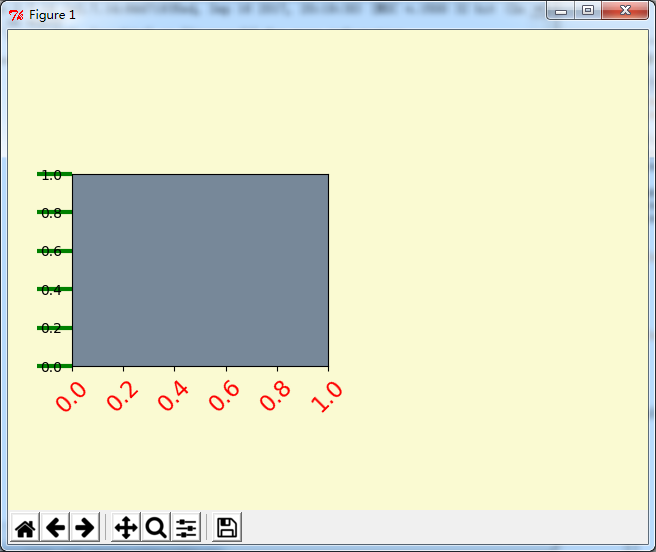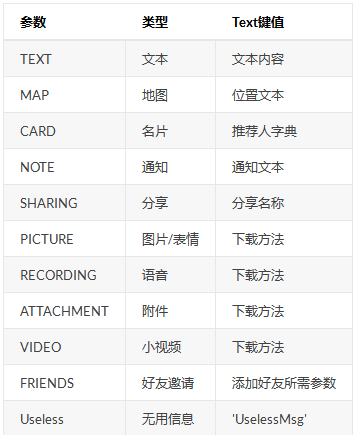Python学习笔记之Django创建第一个数据库模型的方法
Django里面集成了SQLite的数据库,对于初期研究来说,可以用这个学习。
第一步,创建数据库就涉及到建表等一系列的工作,在此之前,要先在cmd执行一个命令:
python manage.py migrate
这个命令就看成一个打包安装的命令,它会根据mysite/settings.py的配置安装一系列必要的数据库表
第二步,我们要建立一个Model层,修改demo/model.py:
from django.db import models
classQuestion(models.Model):
question_text = models.CharField(max_length=200)
pub_date = models.DateTimeField('date published')
classChoice(models.Model):
question = models.ForeignKey(Question, on_delete=models.CASCADE)
choice_text = models.CharField(max_length=200)
votes = models.IntegerField(default=0)
这个Model的内容包括创建表(对象)、确定变量(字段)的类型,以及外键方面的信息
第三步,要激活Model,那么现在helloworld/setting.py中修改:
INSTALLED_APPS =[ 'demo.apps.DemoConfig', 'django.contrib.admin', 'django.contrib.auth', 'django.contrib.contenttypes', 'django.contrib.sessions', 'django.contrib.messages', 'django.contrib.staticfiles', ]
主要是加了第一行的内容,这个在demo/apps下有的。目的是让Django知道有demo这个app。
然后就在cmd下面运行:
python manage.py makemigrations demo
可以看到在demo/migrations/0001_initial.py下面生成了很多代码
继续run这段代码,就完成了建表工作:
python manage.py sqlmigrate demo 0001
再跑一下migrate命令,把这些model创建到数据库表中
python manage.py migrate
第四步,也是比较好玩的了,就是要进入到python django的shell中,执行这个命令:
python manage.py shell

在这个里面,就可以通过命令行操作数据库了
先引入刚才创建好的model:
from demo.models importQuestion,Choice
这个命令,打印出Question所有的对象:
Question.objects.all()
然后创建一个Question的对象(或数据):
from django.utils import timezone q =Question(question_text="What's new?", pub_date=timezone.now()) q.save() q.id q.question_text q.pub_date q.question_text = "What's up?" q.save() Question.objects.all()
第五步,然后polls/models.py中添加以下代码:
from django.db import models from django.utils.encoding import python_2_unicode_compatible @python_2_unicode_compatible# only if you need to support Python 2 classQuestion(models.Model): # ... def __str__(self): return self.question_text @python_2_unicode_compatible# only if you need to support Python 2 classChoice(models.Model): # ... def __str__(self): return self.choice_text import datetime from django.db import models from django.utils import timezone classQuestion(models.Model): # ... def was_published_recently(self): return self.pub_date >= timezone.now()- datetime.timedelta(days=1)
在这里__str__()是一个非常重要的方法,大概可以看成java里pojo对象的一个toString()方法
接下来,就可以在数据库中进行很多操作,在shell中输入以下的代码,就可以执行对数据库的增删查改:
from polls.models importQuestion,Choice Question.objects.all() Question.objects.filter(id=1) Question.objects.filter(question_text__startswith='What') from django.utils import timezone current_year = timezone.now().year Question.objects.get(pub_date__year=current_year) Question.objects.get(id=2) Question.objects.get(pk=1) q =Question.objects.get(pk=1) q.was_published_recently() q =Question.objects.get(pk=1) q.choice_set.all() q.choice_set.create(choice_text='Not much', votes=0) q.choice_set.create(choice_text='The sky', votes=0) c = q.choice_set.create(choice_text='Just hacking again', votes=0) c.question q.choice_set.all() q.choice_set.count() Choice.objects.filter(question__pub_date__year=current_year) c = q.choice_set.filter(choice_text__startswith='Just hacking') c.delete()
操作django Admin
Django的管理端可以管理站点、管理账户权限等等。
在cmd运行以下的脚本创建账户:
python manage.py createsuperuser Username: admin Email address: admin@example.com Password:********** Password(again):********* Superuser created successfully.
启动server:
python manage.py runserver 8081
访问链接地址:
http://127.0.0.1:8081/admin/
登录界面:
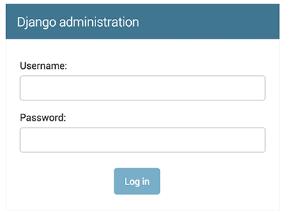
管理界面:

在demo/admin.py中添加代码注册对象:
from django.contrib import admin from.models importQuestion admin.site.register(Question)
刷新后即增加这个对象:
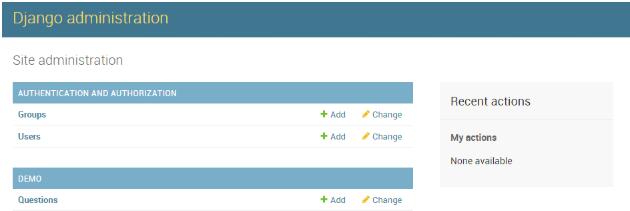
点击Questions进去:
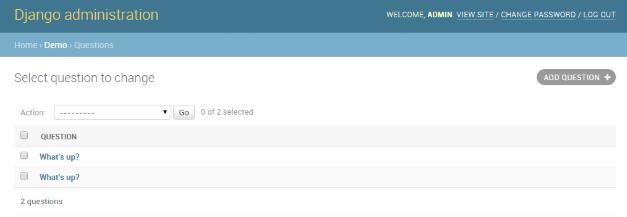
这样,就可以在图形化的界面中执行增删查改了。
以上这篇Python学习笔记之Django创建第一个数据库模型的方法就是小编分享给大家的全部内容了,希望能给大家一个参考,也希望大家多多支持【听图阁-专注于Python设计】。
